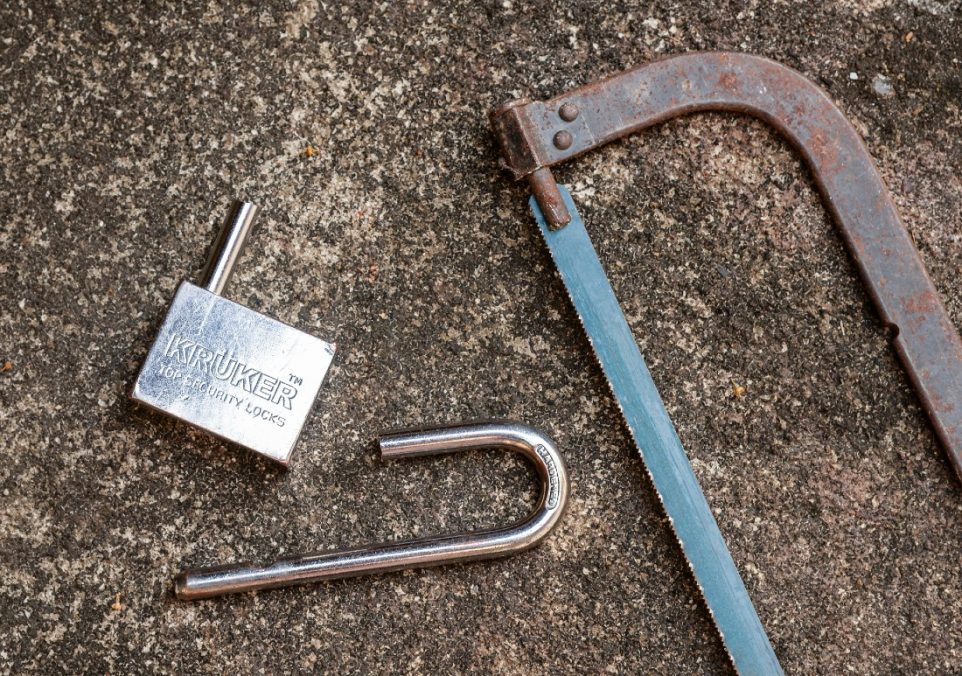8 Effective Methods To Break a Padlock When You Can’t Find the Key

Padlocks serve as reliable security measures for safeguarding our belongings, yet there may come a time when breaking one becomes unavoidable. Knowing effective methods to safely and responsibly break a padlock is essential, whether it’s a misplaced key, a forgotten combination, or a crucial emergency.
We’ll explore eight reliable techniques to utilize under legitimate circumstances or when you own the property inside. Remember, breaking a padlock should always be a last resort, and respecting others’ belongings and privacy remains paramount. Let’s dive into these methods to equip you with the knowledge you need to handle any padlock situation.
1. Bolt Cutters
Bolt cutters are powerful tools to slice through the shackle of a padlock. To break a padlock with bolt cutters, position the jaws around the shackle and apply force by squeezing the handles together. This method is most effective on standard padlocks with thin pieces. It might not work on heavy-duty or high-security padlocks with thicker metal components.
2. Angle Grinder
The angle grinder is a versatile tool that uses a rotating abrasive disc to cut through various materials, including metal. To break a padlock with an angle grinder, secure the padlock in a stable position and carefully cut through the shackle. This efficient method requires caution due to potential sparks and flying debris. Ensure proper safety equipment, such as goggles and gloves, are used while using the angle grinder.
3. Hacksaw
A hacksaw can be a reliable alternative if you don’t have access to bolt cutters or an angle grinder. Choose a sturdy hacksaw blade and firmly saw back and forth along the shackle until it weakens and eventually breaks. This method takes more time and effort than power tools, but it is a practical option for basic padlocks.
4. Lock Picking
Lock picking is a skill professional locksmiths use to bypass locks without causing any damage. While it may take time and practice to master, it’s an invaluable technique to possess. Lock picking requires a set of specialized tools like tension wrenches and picks.
5. Bumping Technique
The bumping technique is another non-destructive method to open certain types of padlocks. It involves using a specially crafted bump key that, when inserted and struck, momentarily forces the lock’s pins into alignment, allowing the lock to open. This trick only works on older pin-tumbler locks and is not as reliable on modern high-security padlocks.
6. Drilling
Drilling is a last resort option if all other methods fail. To break a padlock using this method, use a power drill with a strong drill bit to create a hole in the lock’s casing, focusing on the mechanism or pins inside. This step will open the lock and allow you to open it with minimal damage. Drilling will render the padlock unusable, so only choose this method if no other options are available.
7. Freeze and Hammer
This unconventional method exploits the properties of metal contraction when exposed to extreme cold. Spray the padlock with compressed air or freeze spray for several seconds to make the metal brittle, then use a hammer or similar tool to strike the shackle forcefully. The sudden impact on the chilled metal can cause it to crack and break.
8. Lock Dissolver
Lock dissolvers are chemical solutions to penetrate the internals of a padlock, causing the lock to seize and ultimately break open. This method should be used with caution, as the chemicals can harm the environment and may damage surfaces around the padlock.
Conclusion
Breaking a padlock should only be attempted in legitimate scenarios or when you own the property and have the right to access it. Respecting others’ belongings and privacy is essential, and avoid using these techniques for illegal purposes. If you are in a situation where you need to break a padlock, consider seeking the help of a professional locksmith to avoid unnecessary damage. Always prioritize safety and be responsible when attempting these methods.